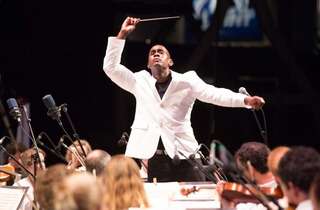|
Back
Patriotic Pops pops Ahead of the 4th Atlanta
Verizon Wireless Ampitheatre
06/28/2014 -
Francis Scott Key: The Star-Spangled Banner
Aaron Copland: Rodeo: “Hoe-Down”
John Philip Sousa: Washington Post March – Stars and Stripes Forever
Kenneth Alford (F.J. Ricketts): Colonel Bogey March
John Williams: Star Wars: ”Imperial March” – The Cowboys Overture
Hoagy Carmichael: Georgia on my Mind
James Reese Europe: Castle House Rag
George M. Cohan: George M. Cohan Medley
Morton Gould: American Salute
Leroy Anderson: Bugler’s Holiday
George Gershwin: Porgy and Bess: ”Summertime”
Bob Lowden (arr.): Armed Forces Salute
Samuel A. Ward: America the Beautiful
Pytor Ilyich Tchaikovsky: 1812 Overture, opus 49
Atlanta Symphony Orchestra, Joseph Young (Conductor)

(© Jeff Roffman)
Atlanta Symphony Orchestra (ASO) got a head start to next week’s Independence Day celebrations by vacating its anchored domicile to sojourn over to the bosky address in Alpharetta. Leading the one-night musical “Stars and Stripes” soirée was maestro Joseph Young, recently appointed Assistant Conductor for the ASO. The demure, soft-spoken gentleman was responsible for the evening’s selections which were thoughtfully chosen and positioned in nice variation, interspersed with musical tributes to our Armed Forces and to The United States of America.
Divided into two sections, the Symphony appeared more vibrant, overall, during the second half than in the portion leading up to intermission. Perhaps due to change in weather, what began with quasi-humid conditions gradually melted away into a balmy, breezy evening. Young’s pacing was brisk, not rushed.
Mr. Young did not introduce himself until after Copland’s “Hoe-Down”, a piece which got better in the second half. Composers’ compositions were well represented: the “Imperial March” from Star Wars had a consistent percussive droning while flute trills were excellent. Even the audience enthusiastically whistled its way through the familiar portions of Colonel Bogey March, the Kenneth Alford music closely associated with the 1957 movie, The Bridge on the River Kwai.
What usually emanates from a “Pops” concert is the ability for brass and woodwinds to shine. The oft-recognized Ray Charles’ rendition of Georgia on my Mind was nicely expressed in orchestral version featuring a flowing strings’ section and trumpets. Joseph Young ventured into the Ragtime genre by paying tribute to James Reese Europe with the Castle House Rag, exuding brightness and happiness akin to Scott Joplin. The Cowboys Overture dappled in melodic Copland-“Hoe-Down” similarities with its Far West ruggedness and galloping jauntiness.
Opening the second half, Morton Gould’s American Salute, a “variations-on-a-theme” approach using Patrick Gilmore’s When Johnny Comes Marching Home foundation, conjured images of the Civil War with wonderful displays of staccatos by the flutes. This rather sobering piece soon made a 180 degree turn leading into the piéce de résistance for any trio of trumpeters in a spectacular rendition of Trumpeter’s Holiday by Leroy Anderson. This is simply an extraordinary piece, a marvel to watch and to listen. The entire Atlanta Symphony did a fabulous job in expressing the frivolity of the score.
The program would not be complete without saluting all of our armed forces. Bob Lowden’s Armed Forces Salute was the fitting musical laudation to honor our heroes, both past and present, that the ASO expressed with politesse digne. Light on compositions in nature for the outdoor arena, no program would be complete without the grandeur of the Tchaikovsky 1812 Overture. The display (especially brass) was ebulliently majestic and definitely a crowd-pleaser. Young’s program closed with the optimistic march-like cadences of John Philip Sousa’s Stars and Stripes Forever, featuring the perkiness of the piccolo.
With quick mention of extraneous details, sound and amplification were excellent. The auditory system picked up soloists with great articulation. Flanking both sides of the stage house wide-screens allowing the audience to better observe orchestral close-ups. On balance, cameras did a fine job of moving cameras around for variety, incorporating nice fades and pans, but there were several moments when the camera was shaking, and in several instances closing shots ended the composition with desultory abruptness, coming across as amateurish. This performance aspect is deemed unpolished, and more attention should be placed toward fine tuning.
The programme’s prolix of casual content can warrant a “notching down” of formality, but, nonetheless, professionalism in standards and continued consistency is something to bear in mind.
Christie Grimstad
|